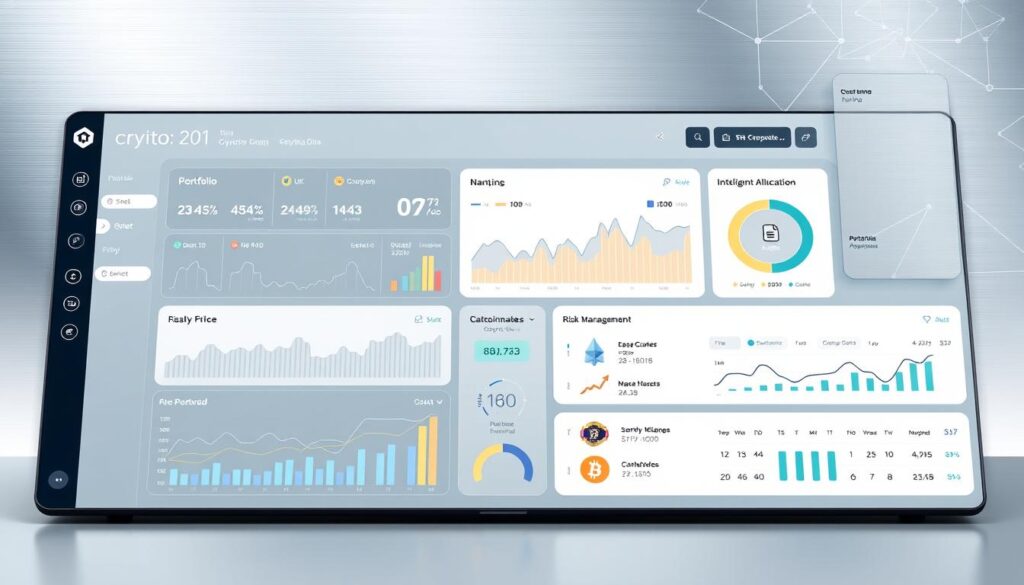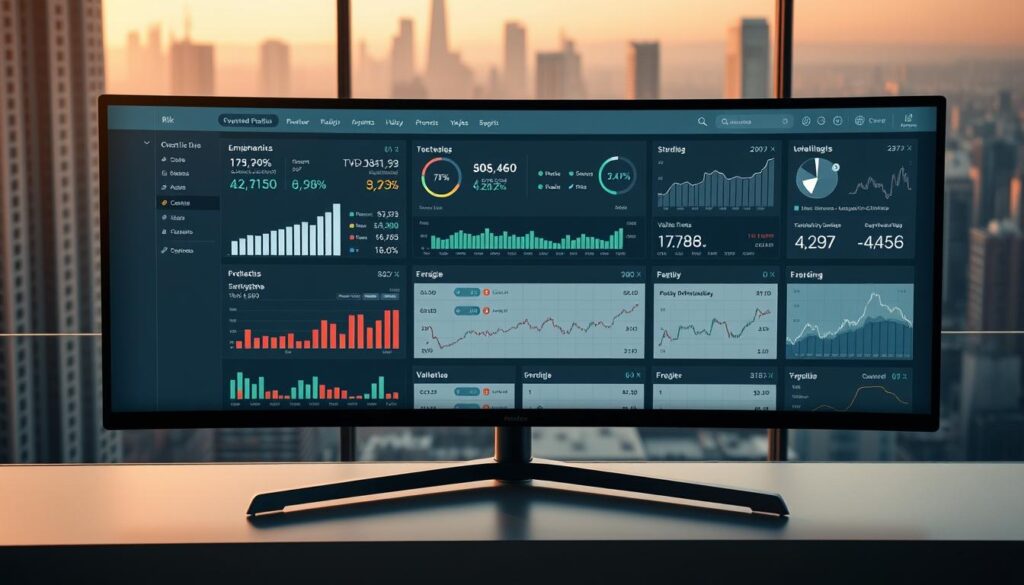The digital asset landscape has transformed dramatically. What began as a niche for individual traders now attracts major financial institutions, with global regulations evolving to support secure custody and diversified holdings. From altcoins to NFTs, modern investors require adaptive strategies to navigate this fast-paced environment.
Today’s markets demand more than basic charts or reactive trades. Professionals seek data-driven solutions that unify real-time metrics, risk assessments, and predictive modeling. These systems analyze vast datasets—from market sentiment to blockchain activity—to identify trends invisible to manual methods.
Regulatory clarity in regions like the U.S. and Singapore has accelerated institutional adoption. Multi-asset exposure is now standard, blending stablecoins, staking rewards, and decentralized tokens. This complexity underscores the need for tools that automate rebalancing while minimizing human bias.
Key Takeaways
- Major financial players now participate in digital asset markets, increasing demand for sophisticated strategies
- Regulatory advancements enable safer, more structured investment approaches
- Modern portfolios often combine multiple asset types requiring coordinated oversight
- Advanced analytics help decode market patterns across exchanges and time zones
- Automated rebalancing reduces emotional decision-making during volatility
- Institutional-grade security measures align with evolving compliance standards
Market Trends and the Evolution of Crypto Portfolio Management
The entry of major banks into digital asset markets marks a new era for investors. Traditional finance giants now allocate billions to tokens and decentralized protocols, reshaping how value moves across global exchanges. This shift demands tools that adapt to both volatile conditions and emerging compliance standards.
Institutional Adoption and Regulatory Shifts
Wall Street firms and asset managers increasingly view crypto as a core holding. Over 40% of U.S. hedge funds now include digital assets in their strategies, per recent industry surveys. Clearer rules in Singapore and the EU help institutions deploy capital confidently while meeting audit requirements.
Regulators now mandate transparent reporting for cross-border transactions and custody solutions. These changes push traders toward systems that automatically log trades and generate compliance-ready documentation. Manual spreadsheets can’t keep pace with multi-jurisdictional demands.
Rise of Automation and Real-Time Analytics
Tracking positions across 10+ wallets and exchanges wastes hours weekly for active traders. Automated systems now sync balances, calculate profit/loss ratios, and trigger rebalancing alerts. One study showed these tools reduce operational errors by 62% compared to manual methods.
Live data streams enable smarter decisions during sudden market swings. Advanced analytics detect arbitrage chances between platforms faster than human analysis. This speed becomes critical when managing diverse assets like stablecoins and staking derivatives.
The Impact of AI on Cryptocurrency Investment Strategies
Investment approaches in digital markets have shifted from intuition-driven moves to precision-guided systems. Sophisticated tools now process terabytes of market signals—price fluctuations, liquidity shifts, and social chatter—to uncover hidden opportunities. These methods outperform manual analysis by identifying patterns across time zones and asset classes.
Enhancing Decision-Making Processes
Modern algorithms evaluate hundreds of variables simultaneously. They track everything from whale wallet movements to derivatives market shifts. This depth enables strategies that adapt within milliseconds during flash crashes or rallies.
Machine learning models improve their accuracy by analyzing historical outcomes. They test hypotheses against live data streams, refining entry/exit rules for better performance. Unlike static plans, these systems evolve with regulatory changes and emerging token dynamics.
Eliminating Emotional Bias in Trading
Human traders often chase losses or exit positions prematurely during volatility. Automated systems follow predefined risk parameters, executing orders without hesitation. Studies show this reduces error rates by 58% compared to manual methods.
By removing greed and fear from equations, tools maintain discipline during market extremes. They lock profits at target levels and cut losses using mathematical thresholds. For those exploring advanced trading strategies, this objectivity becomes critical in volatile conditions.
Essential Features of AI cryptocurrency portfolio management platform
Sophisticated digital asset systems now prioritize precision tools that adapt to evolving market conditions. These solutions combine automated adjustments with deep analytical insights, helping users maintain strategic positioning across volatile markets.

Automated rebalancing stands out as a critical function, maintaining target allocations through scheduled updates or real-time triggers. Systems compare current holdings against predefined rules, executing trades when deviations exceed set thresholds. This eliminates manual calculations during rapid price swings.
Risk evaluation tools like Value-at-Risk models quantify potential losses under different scenarios. Combined with maximum drawdown tracking, these features help investors understand exposure during market stress. Real-time dashboards display Sharpe ratios and volatility metrics for quick performance assessments.
Top-tier platforms connect directly to major trading venues and self-custody solutions. This unified access lets users manage spot positions, staking rewards, and DeFi yields from one interface. Cross-platform synchronization ensures accurate balance tracking without spreadsheet imports.
Strategy automation enables hands-free execution of dollar-cost averaging plans and grid-based approaches. Customizable alerts notify users about rebalancing events or sudden liquidity shifts. Detailed reports simplify tax preparation and compliance audits through organized trade histories.
These capabilities work together to create disciplined, data-driven approaches. By combining mathematical rigor with broad market access, modern systems help investors navigate digital markets more effectively than manual methods allow.
Top Product Roundup: Comparing Leading Crypto Management Tools
Automated systems now dominate digital asset strategies, offering precision that manual methods can’t match. Three standout solutions cater to different experience levels while delivering robust trading capabilities.

Key Highlights from Top-Rated Platforms
Leading tools balance power with accessibility. 3Commas supports complex strategies through 16+ exchange connections, including advanced bots for dollar-cost averaging. Cryptohopper covers 75+ assets across major venues like Binance, while TradeSanta simplifies automation for newcomers.
| Feature | 3Commas | Cryptohopper | TradeSanta |
|---|---|---|---|
| Supported Exchanges | 16+ | 12+ | 9+ |
| Cryptocurrencies | Unlimited* | 75+ | 30+ |
| Unique Tools | Smart Trades | Strategy Marketplace | Template Library |
| Best For | Advanced Strategies | Asset Diversity | Beginner Automation |
Integrating Advanced Trading Bots and Analytics
Modern systems combine automated execution with deep insights. Users create custom rules for entries/exits while monitoring performance through real-time dashboards. These features help spot trends across multiple venues simultaneously.
Cross-exchange arbitrage becomes practical when tools sync data from various sources. Backtesting capabilities let traders refine approaches using historical patterns before risking capital. Such integrations transform scattered operations into cohesive strategies.
Deep Dive into Automated Trading and Strategy Execution
Systematic approaches now form the backbone of modern digital asset strategies. By combining predefined rules with real-time analysis, these methods help traders maintain discipline across shifting price landscapes. The right tools turn complex scenarios into executable plans without emotional interference.

DCA Bots versus Grid Bots
Dollar-cost averaging (DCA) bots excel in building positions gradually. They purchase assets like Bitcoin at fixed intervals, smoothing out price volatility over months or years. This approach reduces the risk of mistiming market entries during sudden dips or spikes.
Grid bots thrive in choppy markets. They place simultaneous buy orders near support levels and sell orders at resistance points for tokens like Dogecoin. When prices oscillate within a range, these systems capture profits through repeated micro-transactions.
Adapting to Dynamic Market Conditions
Successful execution requires adjusting strategies as volatility shifts. During bull runs, DCA bots secure gains by selling portions of holdings at predetermined targets. Grid bots widen their price ranges when markets trend strongly to avoid getting trapped in rapid moves.
Advanced systems monitor trading volume and technical indicators to optimize settings automatically. They might reduce position sizes during high-risk periods or activate stop-loss protocols if liquidity dries up. This flexibility helps protect capital while seeking opportunities.
Combining both approaches creates resilience. Long-term accumulation pairs with short-term profit capture, letting traders benefit from multiple market phases simultaneously. The result? Consistent growth without constant screen time.
Risk Management and Analytics for Optimized Performance
Navigating volatile markets requires more than intuition—it demands precise safeguards. Modern tools quantify exposure through mathematical models while maintaining strategic positioning. Three components form this protective framework: loss prevention protocols, performance measurement, and adaptive decision systems.

Implementing Stop-Loss and Value-at-Risk Systems
Value-at-Risk (VaR) models calculate worst-case losses over set periods. These projections help set position limits during high volatility. Combined with maximum drawdown analysis, traders see how assets might perform in historical stress scenarios.
Real-time dashboards track profit/loss ratios and correlation metrics across holdings. This visibility enables swift adjustments when markets shift unexpectedly. Automated stop-loss orders execute exits at predefined thresholds, removing emotional delays.
| Risk Metric | Purpose | Data Source | Implementation |
|---|---|---|---|
| VaR (95% confidence) | Predict maximum 24h loss | Price history + volatility | Daily position sizing |
| Maximum Drawdown | Measure historical lows | Portfolio performance data | Strategy stress-testing |
| Sharpe Ratio | Assess risk-adjusted returns | Returns vs. volatility | Performance benchmarking |
| Stop-Loss Triggers | Limit downside exposure | Real-time price feeds | Automated order execution |
Advanced systems calculate beta exposure to measure asset sensitivity against market moves. Historical volatility analysis identifies patterns that might repeat. These insights guide rebalancing decisions while maintaining diversification goals.
By integrating these tools, traders create self-correcting strategies. Systems adjust allocations based on live risk scores rather than hunches. This approach turns uncertainty into structured opportunity.
Integration, API Connectivity, and User Experience
Modern trading tools thrive when they connect smoothly across services. Robust integration bridges gaps between wallets, exchanges, and analytical dashboards. This creates unified workflows for tracking positions and executing strategies.
Seamless Connectivity with Major Exchanges
Leading systems sync with top trading venues through secure APIs. Binance, Coinbase Pro, and Kraken integrations allow real-time balance checks and instant order execution. These connections enable automated strategies across multiple accounts simultaneously.
Decentralized protocols require specialized support. Tools that link to DeFi platforms track staking yields and liquidity pool shares alongside traditional holdings. This comprehensive view helps users manage diverse assets efficiently.
| Exchange | API Features | Security Protocols |
|---|---|---|
| Binance | Real-time trading, historical data | IP whitelisting, 2FA |
| Coinbase Pro | Portfolio analytics, fee tracking | Withdrawal limits, AES-256 |
| Kraken | Margin trading, futures data | API key permissions, cold storage |
User-friendly dashboards transform complex data into actionable insights. Customizable widgets display performance metrics across devices. Mobile apps send push alerts for price thresholds or system updates.
Security remains paramount without sacrificing convenience. Systems encrypt API keys and restrict withdrawal capabilities. Two-factor authentication adds protection during login attempts and critical transactions.
Maximizing Portfolio Diversification and Arbitrage Opportunities
Smart investors leverage diverse approaches to protect and grow their holdings. Combining multiple tactics helps mitigate risk while capitalizing on price discrepancies across global markets. This dual focus creates resilience against volatility.
Advanced tools now simplify complex maneuvers once limited to institutional players. ArbitrageScanner exemplifies this shift, scanning 40+ centralized and decentralized exchanges without API integration. Users spot spreads between spot/futures markets, potentially securing 15%+ returns on price gaps.
Cross-Exchange Arbitrage Strategies
Price differences across trading venues create lucrative opportunities. Systems like ArbitrageScanner identify mismatches in real-time, enabling instant execution. This approach works particularly well with high-volume assets experiencing temporary liquidity imbalances.
Dynamic Asset Allocation Methods
Seasoned traders adjust their mix based on market signals and risk profiles. Automated rebalancing maintains target weightings for stablecoins, altcoins, and other assets. This discipline prevents overexposure during sudden rallies or crashes.
Together, these strategies form a robust framework for modern investors. They turn market inefficiencies into advantages while preserving long-term growth potential.


No comments yet